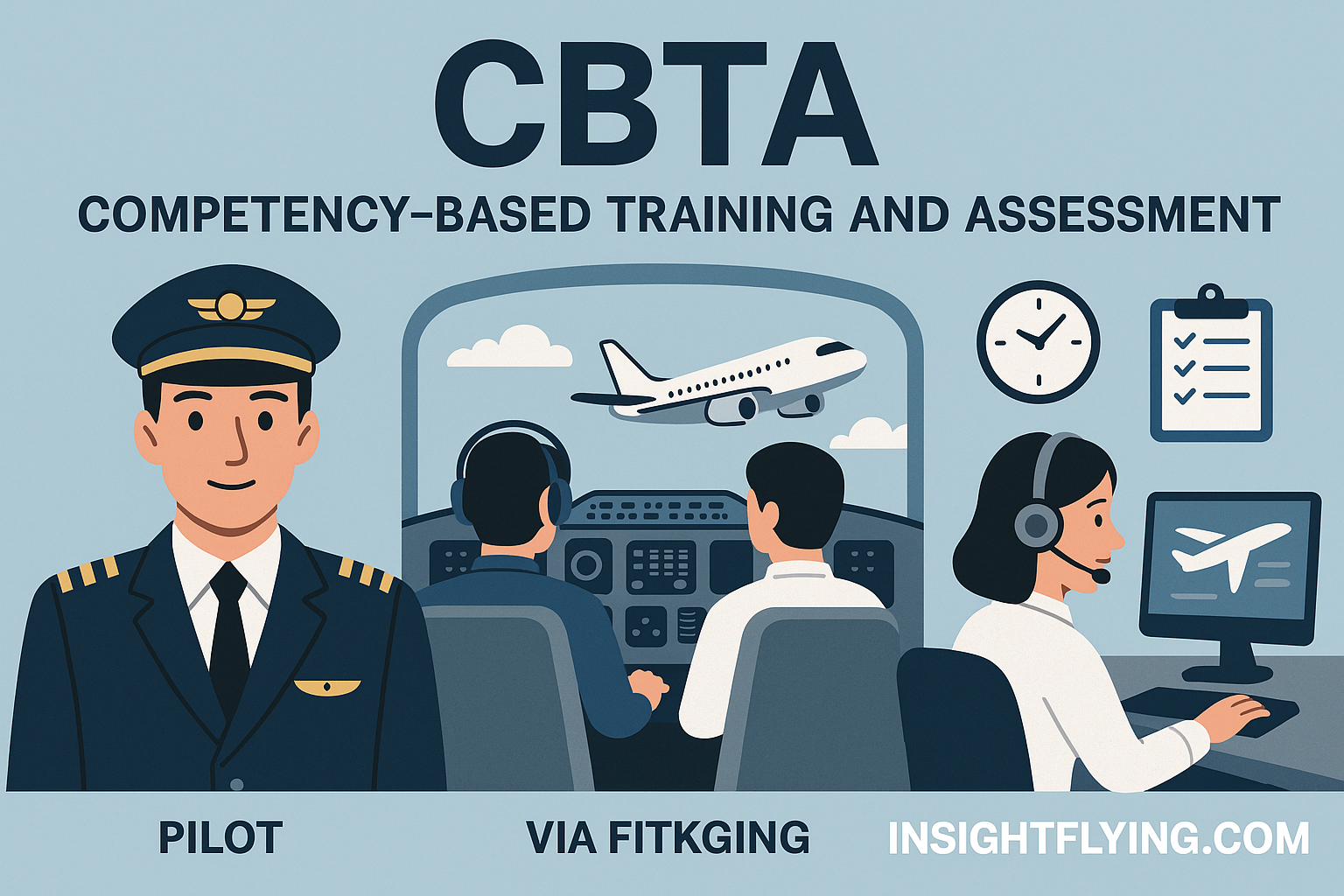CBTA คือ Competency-Based Training and Assessment หรือ การฝึกอบรมและการประเมินตามสมรรถนะ ครับ ✈️
เป็นแนวคิดด้านการพัฒนาบุคลากรในอุตสาหกรรมการบินที่ ICAO และ EASA ผลักดันอย่างมาก โดยเน้นว่า นักบิน ลูกเรือ เจ้าหน้าที่ภาคพื้น หรือแม้กระทั่งพนักงานอำนวยการบิน (dispatcher) ไม่ได้ถูกวัดแค่ “ความรู้ทฤษฎี” แต่ต้องมี สมรรถนะ (Competency) ที่ประกอบด้วย 3 องค์ประกอบหลัก:
- Knowledge (ความรู้) – เข้าใจทฤษฎี กฎระเบียบ 절 ขั้นตอน และข้อมูลที่จำเป็น
- Skills (ทักษะ) – สามารถนำความรู้ไปปฏิบัติ ใช้เครื่องมือ เทคนิค หรือวิธีแก้ปัญหาได้จริง
- Attitudes (ทัศนคติ) – มีความคิด ความเชื่อ และพฤติกรรมที่เอื้อต่อความปลอดภัย การสื่อสาร และการทำงานเป็นทีม
🔑 จุดสำคัญของ CBTA คือ
- เรียนตามผลลัพธ์ (Outcome-based) → ไม่ใช่ว่าเรียนครบชั่วโมงก็จบ แต่ต้อง “ทำได้จริง” ตามที่มาตรฐานกำหนด
- การประเมินต่อเนื่อง → ไม่ใช่สอบครั้งเดียว แต่ดูพัฒนาการและความสม่ำเสมอ
- การเน้นพฤติกรรม → เช่น situation awareness, decision making, teamwork, leadership, workload management
📌 ตัวอย่างในโลกการบิน
- การฝึกนักบินใน simulator ไม่ใช่แค่ทำ maneuver ได้ แต่ต้องดูการตัดสินใจในสถานการณ์วิกฤติ (competency in decision-making)
- การฝึกพนักงานอำนวยการบิน (dispatcher) ต้องเน้นไม่เพียงแค่การวางแผนเส้นทาง แต่รวมถึงการจัดการข้อมูลสภาพอากาศ การสื่อสารกับนักบิน และการแก้ปัญหาเมื่อสถานการณ์เปลี่ยน
CBTA จึงเป็นการสร้าง “นักบิน/บุคลากรที่พร้อมจริง” ไม่ใช่แค่ “ผ่านข้อสอบ” ครับ
📌 ICAO CBTA – 8 Core Competencies for Pilots
| Core Competency | คำอธิบาย | องค์ประกอบ (KSA) |
|---|---|---|
| 1. Application of Procedures (การปฏิบัติตามขั้นตอน) | ปฏิบัติตาม SOP, checklists, regulations อย่างถูกต้องและปลอดภัย | Knowledge: เข้าใจกฎ/ขั้นตอน Skill: ใช้งาน checklist และ flow ได้คล่อง Attitude: มี discipline และ commitment |
| 2. Communication (การสื่อสาร) | ถ่ายทอดและรับสารอย่างมีประสิทธิภาพทั้งในและนอก cockpit | Knowledge: phraseology, CRM Skill: ฟัง–พูด–เขียนชัดเจน Attitude: openness, teamwork |
| 3. Aircraft Flight Path Management – Automation | ใช้ระบบ automation (FMS, autopilot) อย่างเหมาะสม ปลอดภัย | Knowledge: system logic, modes Skill: manage modes, monitor effectively Attitude: ไม่ over-rely |
| 4. Aircraft Flight Path Management – Manual Control | ควบคุมอากาศยานด้วยมืออย่างแม่นยำ (basic flying skills) | Knowledge: aircraft handling principles Skill: stick & rudder, energy management Attitude: confidence, adaptability |
| 5. Leadership and Teamwork | นำทีมและทำงานร่วมกันได้ดี สร้างบรรยากาศที่ปลอดภัย | Knowledge: CRM principles Skill: allocate tasks, resolve conflicts Attitude: respect, inclusiveness |
| 6. Problem Solving and Decision Making | วิเคราะห์สถานการณ์ เลือกวิธีแก้ที่เหมาะสม | Knowledge: risk management models Skill: evaluate options, act decisively Attitude: calm under pressure |
| 7. Situational Awareness | รู้ตำแหน่ง สถานะ และสภาวะแวดล้อมรอบตัวเสมอ | Knowledge: threat & error management Skill: scan, cross-check, anticipate Attitude: vigilance |
| 8. Workload Management | จัดลำดับความสำคัญ ควบคุมงานให้เหมาะสมกับเวลาและทรัพยากร | Knowledge: time/resource management Skill: prioritize, delegate, pace tasks Attitude: balance, composure |
🔑 สิ่งที่แตกต่างจากการฝึกแบบเดิม (Hours-based Training):
- ไม่ใช่เรียนครบ 1,500 ชม. แล้วได้ license แต่ต้อง demonstrate competency
- Instructor/Examiner จะสังเกต พฤติกรรม (behavioural markers) เช่น การสื่อสาร, การประสานงาน, การตัดสินใจ ไม่ใช่แค่ maneuver
📌 CBTA – Behavioral Indicators (ตัวชี้วัดพฤติกรรม)
| Core Competency | Positive Indicators (พฤติกรรมที่พึงประสงค์) | Negative Indicators (พฤติกรรมที่ควรระวัง) |
|---|---|---|
| 1. Application of Procedures | – ปฏิบัติตาม SOP/Checklist อย่างครบถ้วน – สื่อสาร cross-check ก่อน action สำคัญ – รักษามาตรฐาน consistent | – ละเลย checklist หรือทำผิดลำดับ – ทำ procedure โดยไม่ verify – ใช้ “short-cut” โดยไม่ผ่าน CRM |
| 2. Communication | – ใช้ ICAO phraseology ถูกต้อง – สื่อสารสั้น กระชับ ชัดเจน – Confirm / acknowledge ข้อมูลที่สำคัญ | – ใช้คำกำกวม / jargon – ไม่ feedback หรือ ignore callouts – ขัดจังหวะ/ไม่ฟังทีม |
| 3. Flight Path Mgmt – Automation | – ใช้ FMS/AP ตาม appropriate level – Monitor flight mode changes – Cross-check data entry | – ไม่ monitor automation (mode confusion) – Depend automation มากเกินไป – ไม่รู้ revert สู่ manual control |
| 4. Flight Path Mgmt – Manual | – ควบคุม attitude, speed, track แม่น – Smooth handling – ใช้ trim และ control inputs ถูกต้อง | – Over-control / under-control – ไม่ maintain stabilized approach – ignore instrument scan |
| 5. Leadership & Teamwork | – Assign task ชัดเจน – รับฟัง input ของทีม – แก้ความขัดแย้งอย่างสร้างสรรค์ | – Dominate cockpit / ignore input – ไม่ delegate tasks – ทำให้บรรยากาศตึงเครียด |
| 6. Problem Solving & Decision Making | – Identify problem ได้เร็ว – Generate options – ตัดสินใจตามข้อมูลและเวลา | – Delay decision / indecisive – Jump to conclusion – ไม่ปรับ decision เมื่อ info เปลี่ยน |
| 7. Situational Awareness | – Maintain big picture – Anticipate threats & plan ahead – Regularly cross-check instruments | – Head-down นานเกินไป – Miss radio calls/traffic/weather – ไม่รู้ตัวเมื่อ out of situ |
| 8. Workload Management | – Prioritize tasks – Manage pace เหมาะสม – Delegate ภาระงานเมื่อ workload สูง | – Focus เรื่องเล็กเกินไปจน miss critical – Task saturation จน communication drop – Panic / rush under pressure |
🔑 การใช้จริงใน Training/Checking
- Instructor/Examiner จะ “observe” และบันทึกว่าผู้ฝึกแสดง positive หรือ negative indicators
- การประเมิน competency จะใช้ grading scale เช่น:
- 1 = Unsatisfactory (ไม่แสดง competency)
- 2 = Below Standard (ต้องการการชี้แนะ)
- 3 = Satisfactory (ทำได้ตามมาตรฐาน)
- 4 = Proficient (ทำได้ดีเกินมาตรฐาน)
CBTA stands for Competency-Based Training and Assessment.
It is a training and development concept in the aviation industry strongly promoted by ICAO and EASA. The key idea is that pilots, cabin crew, ground staff, or even dispatchers are not assessed only on their theoretical knowledge, but on their competencies, which consist of three essential components:
- Knowledge – Understanding theory, regulations, procedures, and necessary information.
- Skills – The ability to apply knowledge in practice, operate tools, techniques, and solve problems effectively.
- Attitudes – The mindset, behaviors, and values that support safety, communication, and teamwork.
🔑 Key features of CBTA:
- Outcome-based learning → Training is not completed simply by accumulating hours; trainees must demonstrate actual competency as defined by standards.
- Continuous assessment → Not a one-time exam, but observation of progress and consistency over time.
- Behavior-focused → Emphasis on observable behaviors such as situational awareness, decision making, teamwork, leadership, and workload management.
📌 Aviation Examples:
- Pilot training in simulators: Evaluation is not only about performing maneuvers, but also about decision-making competency in critical situations.
- Dispatcher training: Focus goes beyond flight planning to include managing weather data, effective communication with pilots, and problem-solving when situations change.
✅ In essence, CBTA aims to develop aviation professionals who are truly competent and operationally ready, not just individuals who can pass exams.
